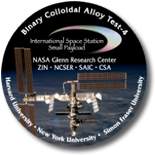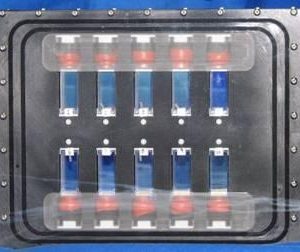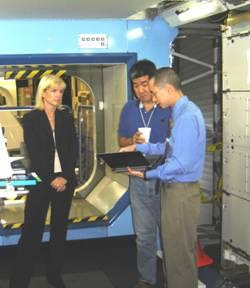Binodal Colloidal Aggregation Test-4
Binodal Colloidal Aggregation Test-4 (BCAT-4)
 The Binodal Colloidal Aggregation Test (BCAT) hardware supports four experiments. The first hardware, Binary Colloidal Alloy Test – 3, consisted of three separate investigations, Binary Alloy (BCAT-3-BA), Critical Point (BCAT-3-4-CP) and Surface Crystallization (BCAT-3-SC), which were delivered to the International Space Station (ISS) during expedition 8. The next hardware, BCAT-4, consists of two separate investigations, Critical Point (a continuation of the investigation on BCAT-3) and Polydispersion (BCAT-4-Poly).
The Binodal Colloidal Aggregation Test (BCAT) hardware supports four experiments. The first hardware, Binary Colloidal Alloy Test – 3, consisted of three separate investigations, Binary Alloy (BCAT-3-BA), Critical Point (BCAT-3-4-CP) and Surface Crystallization (BCAT-3-SC), which were delivered to the International Space Station (ISS) during expedition 8. The next hardware, BCAT-4, consists of two separate investigations, Critical Point (a continuation of the investigation on BCAT-3) and Polydispersion (BCAT-4-Poly).
Binary Colloidal Alloy Test – 4: Critical Point (BCAT-4-CP)
- Binary Colloidal Alloy Test – 3 and 4: Critical Point (BCAT-3-4-CP) uses microscopic spheres (described as colloids) suspended in a liquid to serve as a large scale representation of the atoms and small molecules which constitute typical solids, liquids, and gases so that scientists can visualize what happens at the individual particle level when materials transition from liquids to gases.
- These systems of microscopic spheres help scientists visualize when specific conditions (i.e. temperature, pressure, and concentration) drive the formation of solids, liquids, and gases in smaller systems based upon atoms and simple, small molecules.
- Depending on their relative distances and energies with respect one another, atoms and molecules organize themselves to form gases, liquids, or solids. By varying the concentrations of the microscale spheres, this experiment studies the critical point of these systems where gases and liquids no longer exist as separate entities and a new state of matter forms when one reaches a critical point.
- BCAT-3-4-CP can only be performed in microgravity where gravitational forces do not interfere with the experiment.
- The application of this experiment in the near term is to enhance the shelf life of everyday products and in the longer term, the development of revolutionary materials for electronics and medicine.
Binodal Colloidal Aggregation Test – 4: Polydispersion (BCAT-4-Poly)
- Binodal Colloidal Aggregation Test – 4: Polydispersion (BCAT-4-Poly) consists of microscopic spherical particles (known as colloids) of a variety of different diameters (with the same average size) suspended in a liquid.
- The effects of this diversity in diameter among the particles will be studied with respect its affects on crystallization.
- Crewmembers photograph the samples over time to document the way that the particles crystallize in microgravity.
- Results from these experiments help scientists develop fundamental physics concepts which will enable the development of a wide range of new next generation technologies (such as in high speed computers and advanced optical devices).
The BCAT-4-Poly polydispersed (characterizing the variation in particle size in the dispersed phase) and seeded samples consist of polymethyl methacrylate (PMMA) particles in an index matching decalin/tetralin mixture (the same colloid and solvent materials as the critical-point samples, but at a volume fraction of ~0.59). Although these samples are at or above the so-called glass transition point, colloidal crystals are expected to form. The particle size distribution and the addition of spherical seed particles should affect the free energy barrier for crystal nucleation, that is, the rate at which crystals nucleate. Photography will be used to study their evolution, with the hope of seeing white light backlit samples diffract the light so that the color changes with viewing angle. This will help reveal the shape of the nuclei, which provide information about the way the crystals grow in microgravity. The crystallites might grow fast in certain crystallographic directions which could give them a layer like structure. Also their shape will give some hints about the processes that limit the growth. Comparison with analogous ground-based experiments will reveal differences in the growth behavior in microgravity.


